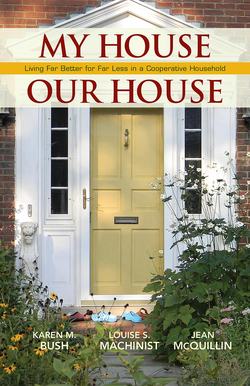Читать книгу My House Our House - Karen M. Bush - Страница 15
На сайте Литреса книга снята с продажи.
Our Model: Living Independently, Together, Through Cooperative Householding
ОглавлениеThe stories of people who have dedicated their time, money, lives and livelihoods to the utopian dream of building better ways to live in community are truly inspiring. In Paul Ray’s wonderful phrase, these are true “cultural creatives.” (See David Wann, “Reinventing Community,” FIC Directory, pg. 7.) In contrast, we followed a much more pragmatic path than an idealistic one. We were motivated primarily by the immediate practical benefits to each of us, and were secondarily aware of the less tangible but broader ramifications for environmental, social and cultural change.
Unlike larger intentional communities, we did not spend years in careful discernment about a shared vision or to establish complex community governance and covenants; we did not need to acquire significant capital or embark on a major construction project. But there are similarities between our model of shared living and others: we proactively found ways to solve problems of living in atypical ways. In certain respects, we probably re-invented the wheel, instead of learning from what other shared housing folks were already doing. Since you are reading this book, at least you won’t have to start from scratch.
We call our shared living model cooperative householding, using the “ing” gerund form to emphasize that this is an active, evolving process, not just a place.
Here’s how we define our model of shared living:
Cooperative householding: A shared housing partnership of two or more unrelated people who co-own, reside in, and jointly manage a residence to gain financial, social, lifestyle, environmental and/or other benefits. (By “unrelated,” we mean that the housemates are homeowner partners, not a nuclear family or a romantic partnership.)
Of course, cooperative householding shares elements with other types of group living, in particular, shared housing/home sharing. What is different is the co-ownership of the residence, an ingredient that we believe is essential from psychological and legal standpoints to ensure equality, i.e., equal power, equal commitment, and equal responsibility, among the partners. Here are the important expectations that come with and derive from our cooperative householding model:
1.Co-owned, co-equal and co-operative.
2.Long-term commitment, but not assumed to be permanent.
3.The partners are independent, not dependent on each other, despite interdependent homeownership.
As co-homeowners, we hold equal shares in each and every aspect of homeownership.
In our cooperative household, we devised our own way to live economically, reaping rich advantages: savings in money, time, labor and environmental impact. In our own way, we created a small community that is also rich in mutual support and fun. From a practical standpoint, we enhanced each member’s lifestyle, at the same time protecting privacy and independence.
Does this sound far-fetched and unrealistic? That’s how it struck Jean’s niece, Goldyn – but not for long.
Honestly? Although outwardly supportive, I thought my aunt was crazy: she and two friends buying a house together?! The first thing that came to my mind was MID-LIFE CRISIS. When I think back to why I thought it so strange, I can’t come up with a good answer, other than I had never heard of anyone else doing it.
Today, I think it’s a marvelous idea and really awesome living arrangement. I have no idea why more people don’t do it! Living with good friends while having a separate living space and not having to share a bathroom is really ingenious.
When I go to my aunt’s house, it doesn’t feel like I am visiting one aunt but more like visiting three. They all know the details of my life, and when we see each other after a long time, we pick right back up where we left off.
It’s guaranteed that each evening will end with a glass of wine next to the fire (I usually visit in winter) and excellent conversation, gossip, or both. It’s just like coming home.
As an outsider looking into Shadowlawn, it’s nice to see that they have each other to share not only the day-to-day experiences but also the peaks and valleys of life. It’s a built-in support system in many ways; like any other family but with less drama. I will react differently the next time someone tells me they’re going to enter a similar living arrangement.
Think about it: if you live alone and have a free evening, how do you spend it? Watching TV by yourself, like many Americans? In our house, one of the three of us will typically suggest a walk, a game (Scrabble, anybody?), a movie, initiate engaging conversation or just plain relaxation. In inviting weather, we take a cold drink out to the “grotto” (a small area under tall trees at the very back of our garden) to get away from it all within just a few feet of our back door.
These little daily social interactions make for a much healthier and happier style of living than the silence of living alone. Yet each of us can and does opt out when we prefer not to join the others. We all need and respect the beauty of solitude as well as socialization. We have the best of both worlds. And we can answer the thought question posed by Women for Living in Community trailblazer Marianne Kilkenny: Who will leave the lights on for you?
To learn more about the many possible ways to live together and to share resources, we invite you to explore our resource list at the end of the book. We find a number of sources to be particularly helpful, including: Creating Community Anywhere (C.R. Shaffer), The Sharing Solution (Janelle Orsi and Emily Doskow), Sharing Housing (Annamarie Pluhar), and Marianne Kilkenny’s Women for Living in Community website, (www.womenlivingincommunity.com).
The chapters that follow offer insider tips about how to create a successful cooperative household. Come with us, retrospectively, on our adventure.
